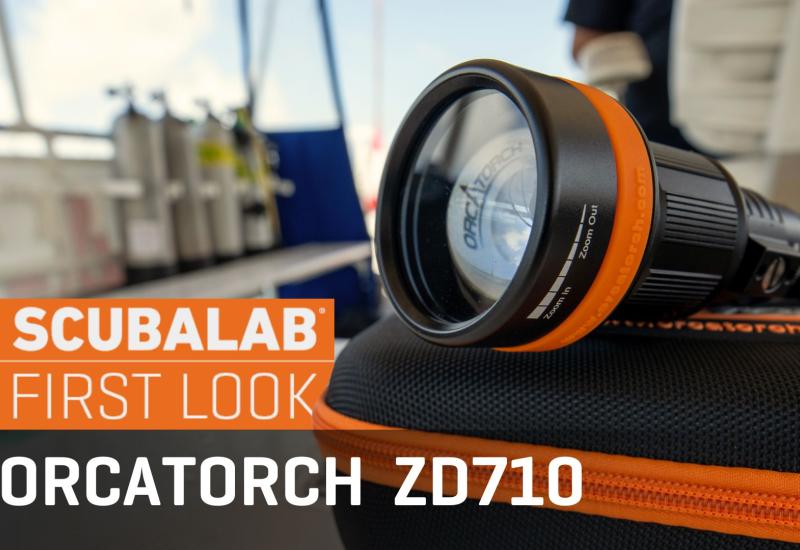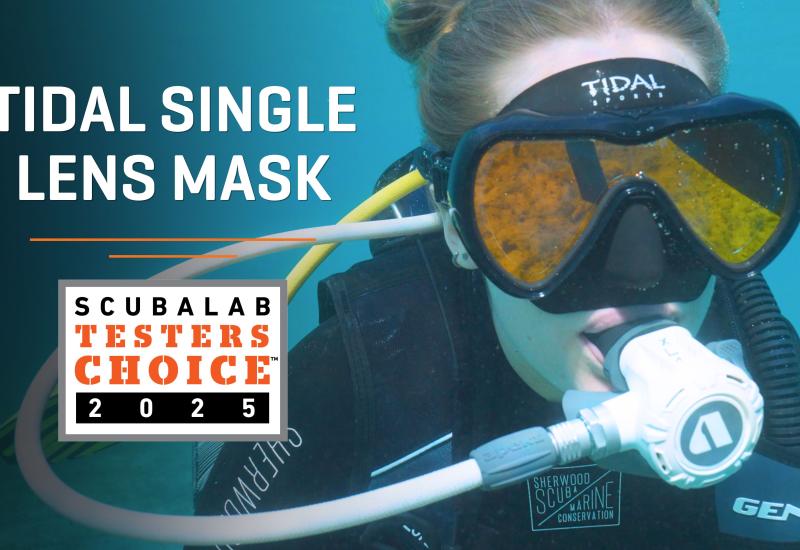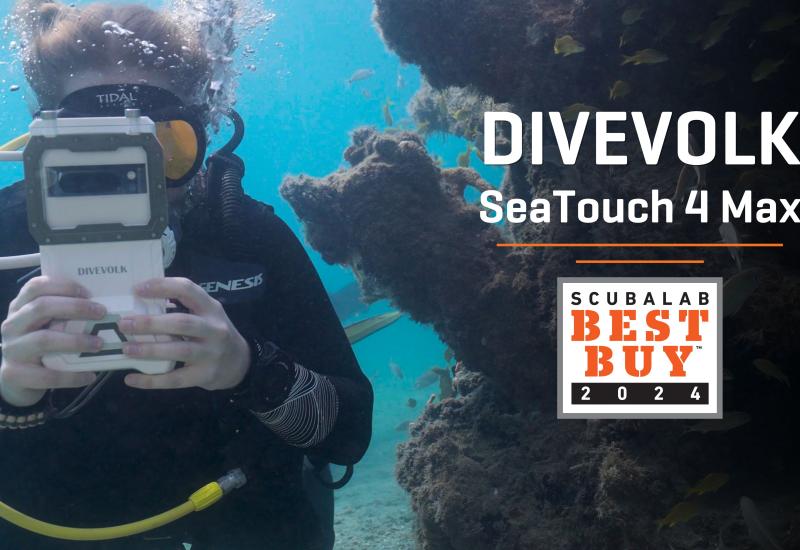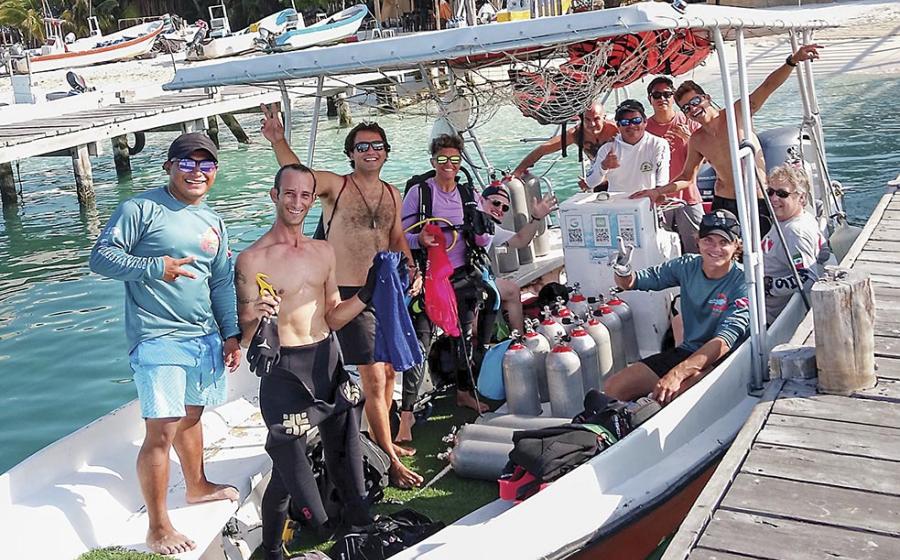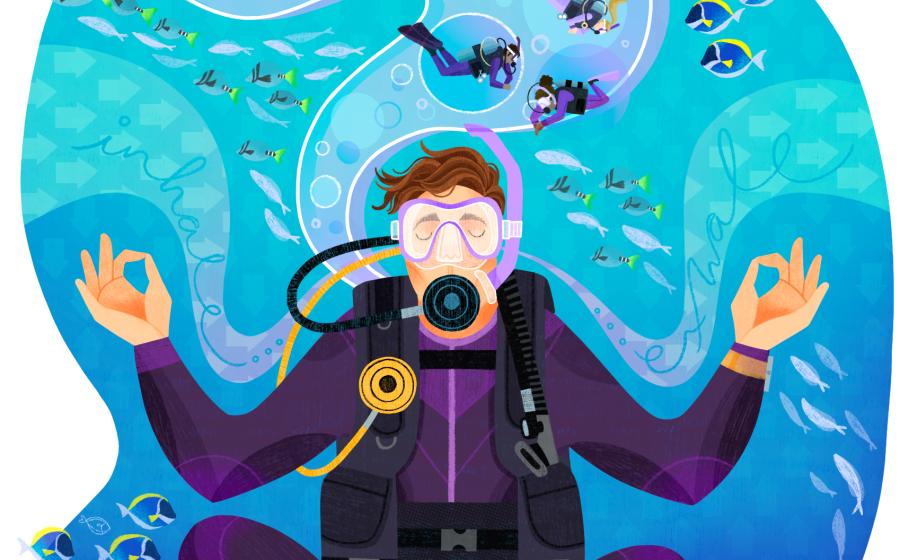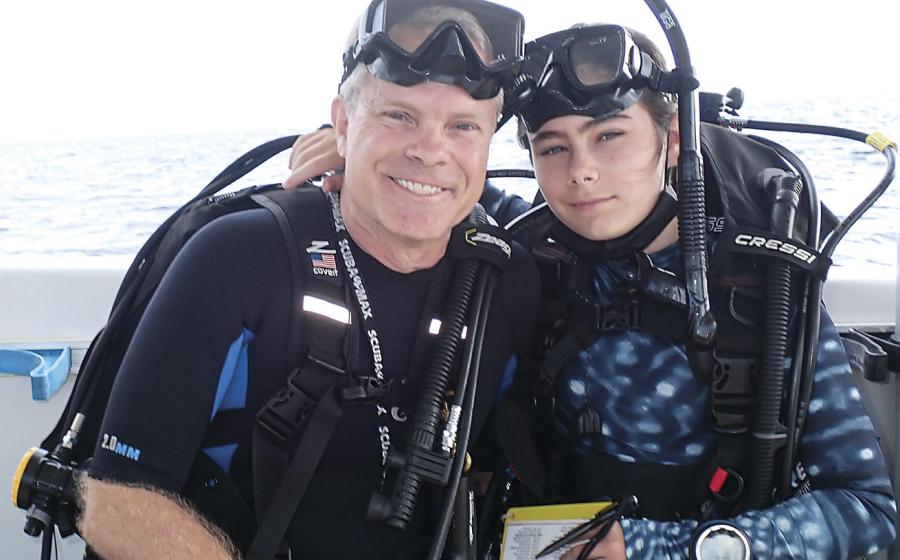Best Scuba Masks: 2016 Mask Review from ScubaLab
Buying a dive mask is one of the best gear investments to make for any level of diver, so it's important to know how to find one that fits your face and style of diving. Here, we test the best masks on sale and show you how to find the perfect one.
HOW WE TEST DIVE MASKS
Dive Mask Test Protocol:
To evaluate the in-water performance of each dive mask, a team of ScubaLab test divers dived with them at Alexander Springs in central Florida. Using underwater slates and waterproof test sheets, divers scored each scuba mask in five performance categories. Our team of divers also recorded comments about their experience with each mask and ranked in order their top three favorites in each of two mask categories — dual-lens and single- lens models.
Ergo Test Categories:
- Ease and security of adjustments, including buckles, swivels and quick releases
- Comfort of the strap, skirt, frame, nose pocket and all contact points
- Dryness overall, and effectiveness of seals and purge valves
- Field of view, both vertical and horizontal
- Mask volume and ease of clearing and equalizing
Because of the importance of proper fit, individual test divers did not proceed with in-water testing if a mask failed to fit him or her properly.
HOW WE SCORE MASKS
Shown on the graph accompanying each mask are that mask's scores for comfort (including the strap, skirt, frame and contact points) and field of view (both horizontal and vertical, as perceived by the diver). The scoring is as follows: 5 = excellent; 4 = very good; 3 = good; 2 = fair; 1 = poor. Test divers also selected their top three favorite masks in each of the two test categories — dual lens and single lens.
MULTI-LENS VS. SINGLE LENS
The choice between mask types is partly a matter of personal preference and partly a function of special requirements a diver might have. Multi-lens masks, especially dual-lens models, generally have a smaller internal volume than single-lens models because their smaller size can allow them to be shaped closer to the diver’s face. A smaller volume is beneficial because it makes a mask easier to clear and equalize. They also can be equipped with corrective lenses, which many manufacturers offer for their most popular masks. Single-lens masks offer the widest uninterrupted field of view because they don’t have the obstruction of the nose bridge needed on a dual- or multi-lens mask. Single-lens masks can’t be fitted with corrective lenses and generally have somewhat larger volume, although many newer designs have significantly reduced volumes.

Q: What factors did test divers find most important?
A: Test divers’ favorite masks took top scores for comfort, with supple skirts, soft nose pockets and no hard parts contacting the face. That's no surprise because an uncomfortable mask can quickly take the fun out of any dive.
Q: What are the pros and cons of frameless masks?
A: Molding the skirt directly to the lens gives the frameless mask a lower profile and eliminates any visual obstruction the frame might cause. Because the frameless masks' lenses aren’t removable, they can’t be fitted with corrective lenses or replaced. — Roger Roy, ScubaLab Director
SEE MORE SCUBA GEAR REVIEWS
Ever wondered why you came up with blood in your dive mask? The Diving Doctor explains what may be causing those nosebleeds.
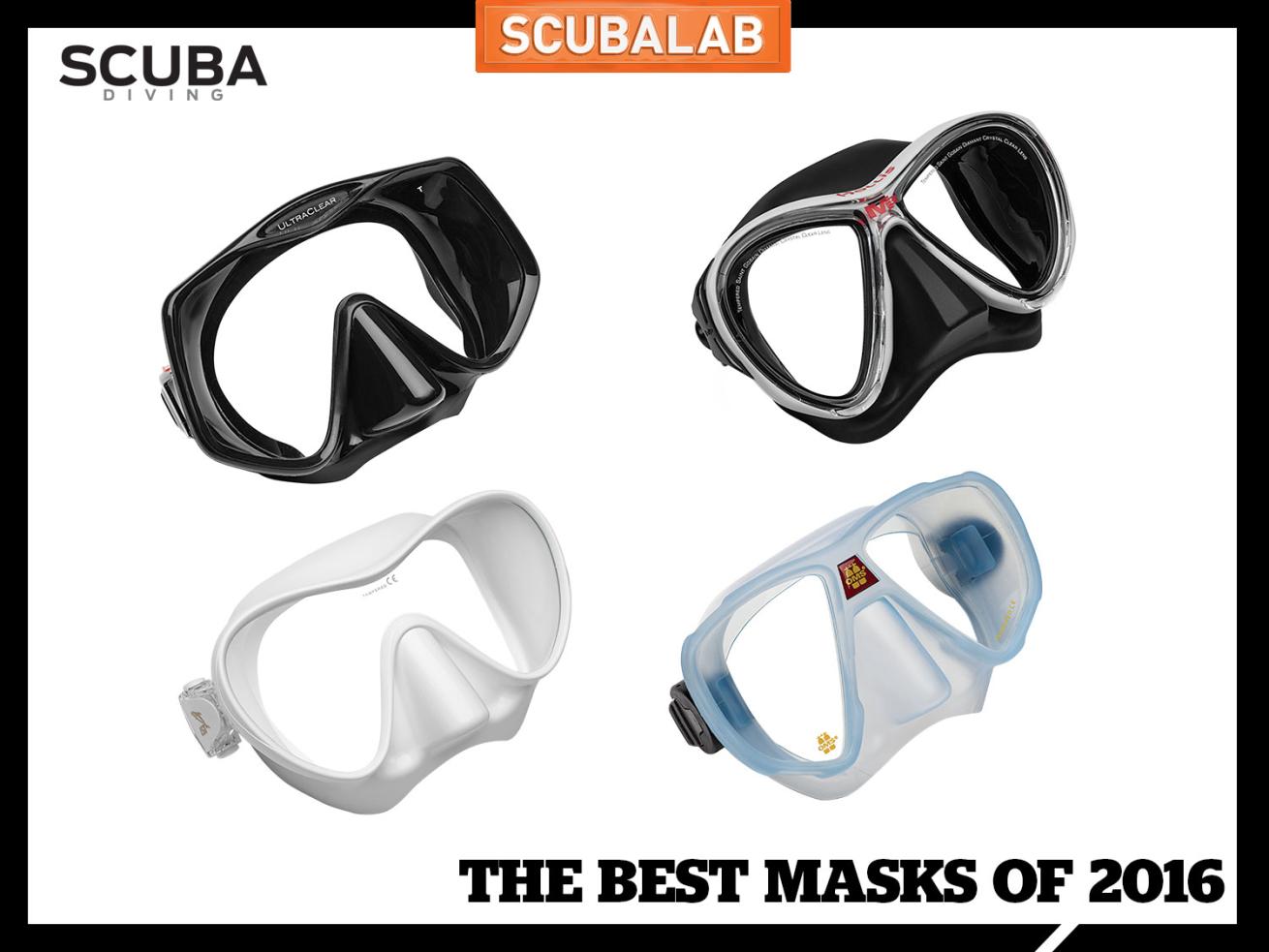
Jon WhittleIn the market for a new dive mask? ScubaLab tested 15 of the latest models available in 2016. Here are the results.
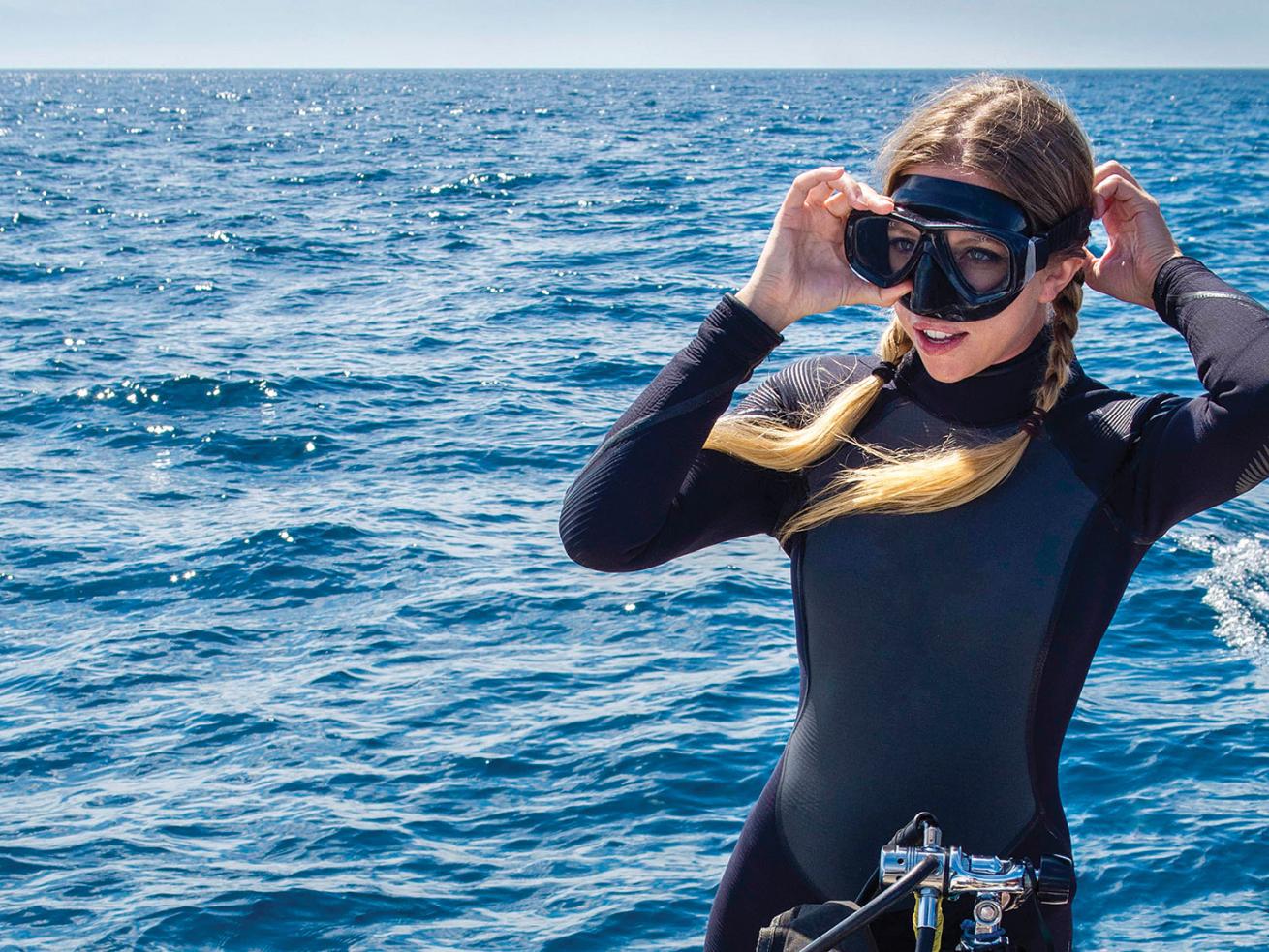
ShutterstockFinding the right mask for your face.
FIND THE RIGHT FIT
No matter how impressive a mask's other qualities might be — the ultrasoft skirt, the broad field of view — if it doesn't properly fit your face it’s simply the wrong mask for you. It's true that the design and materials of today’s masks allow many models to fit a wider variety of face shapes and sizes than in the past. But you might still find that some of the masks you try on won’t seal properly or are simply uncomfortable on your face, especially if they create pressure at points, such as the frame pressing on your forehead. If a mask fails to seal or is uncomfortable when you’re in the dive shop or store, you can be sure it won’t get any better once you're actually in the water. So keep trying on masks until you find the one that gives a perfect seal along the whole length of the skirt and that doesn’t rub or press at the nose pocket, frame or lenses.
Atomic Aquatics Frameless 2
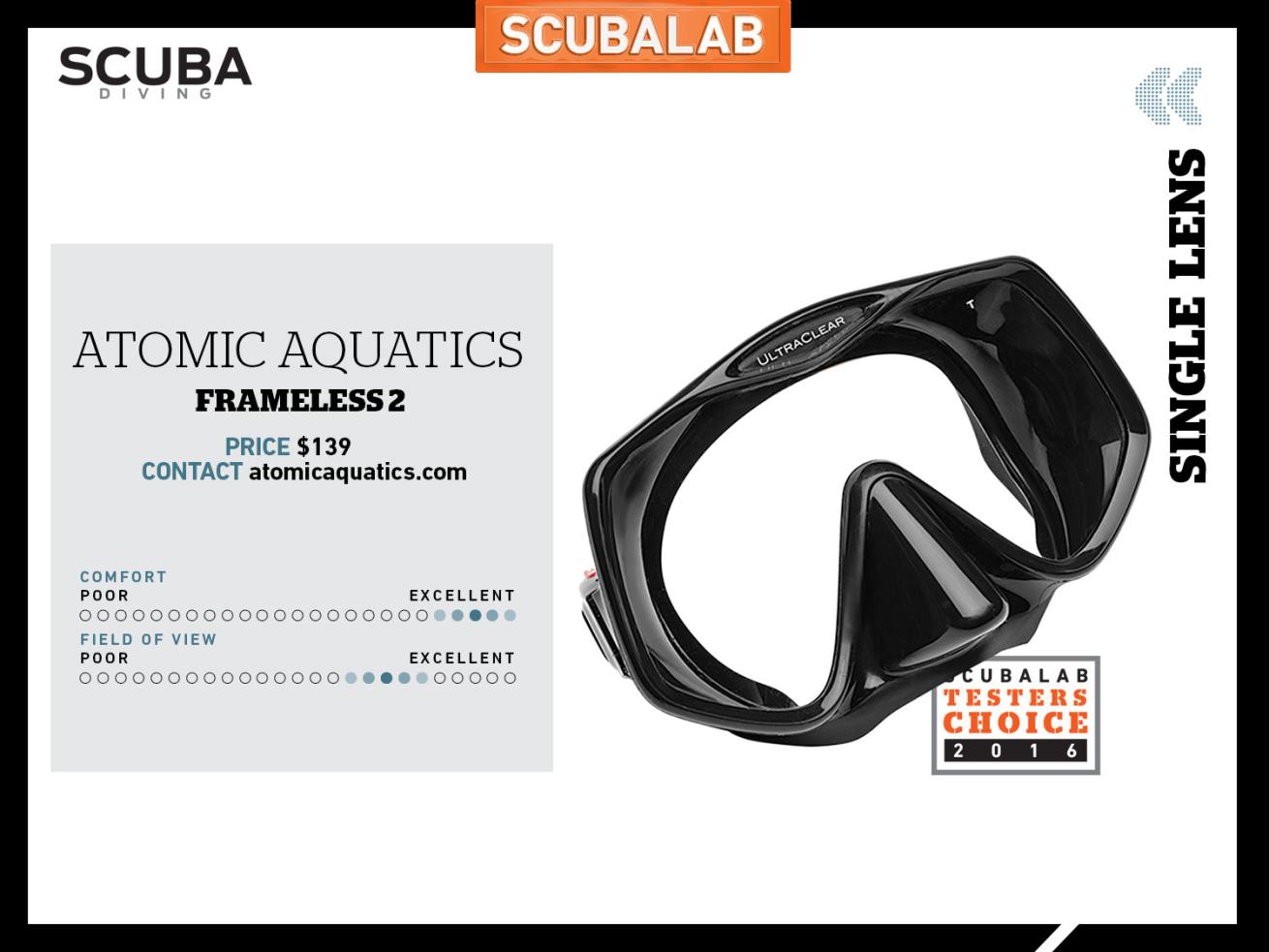
Jon WhittleAtomic Aquatics Frameless 2
The frameless design and soft silicone skirt bring the broad single lens of the Frameless 2 in close for a comfortable, panoramic view with no frame to rub the face or block the view. The lens is of a low-iron glass that reduces distortion, and despite its size, the volume of the mask is noticeably small, making it easy to clear and equalize. The buckles are just right, with a mechanism that adjusts easily and stays put. They swivel only side to side, but are mounted on silicone tabs that allow some up-and-down movement. Both the skirt and the strap are very comfortable. The skirt, strap and buckle helped the Frameless 2 take the highest scores in our test for adjustment and comfort, earning excellent ratings for both. The mask is available in three sizes for optimal fit (we tested the standard size, which fit most of our divers well). The Frameless 2 was our Testers Choice for single-lens masks.
Price $139 Contact atomicaquatics.com
Dive Rite ES155
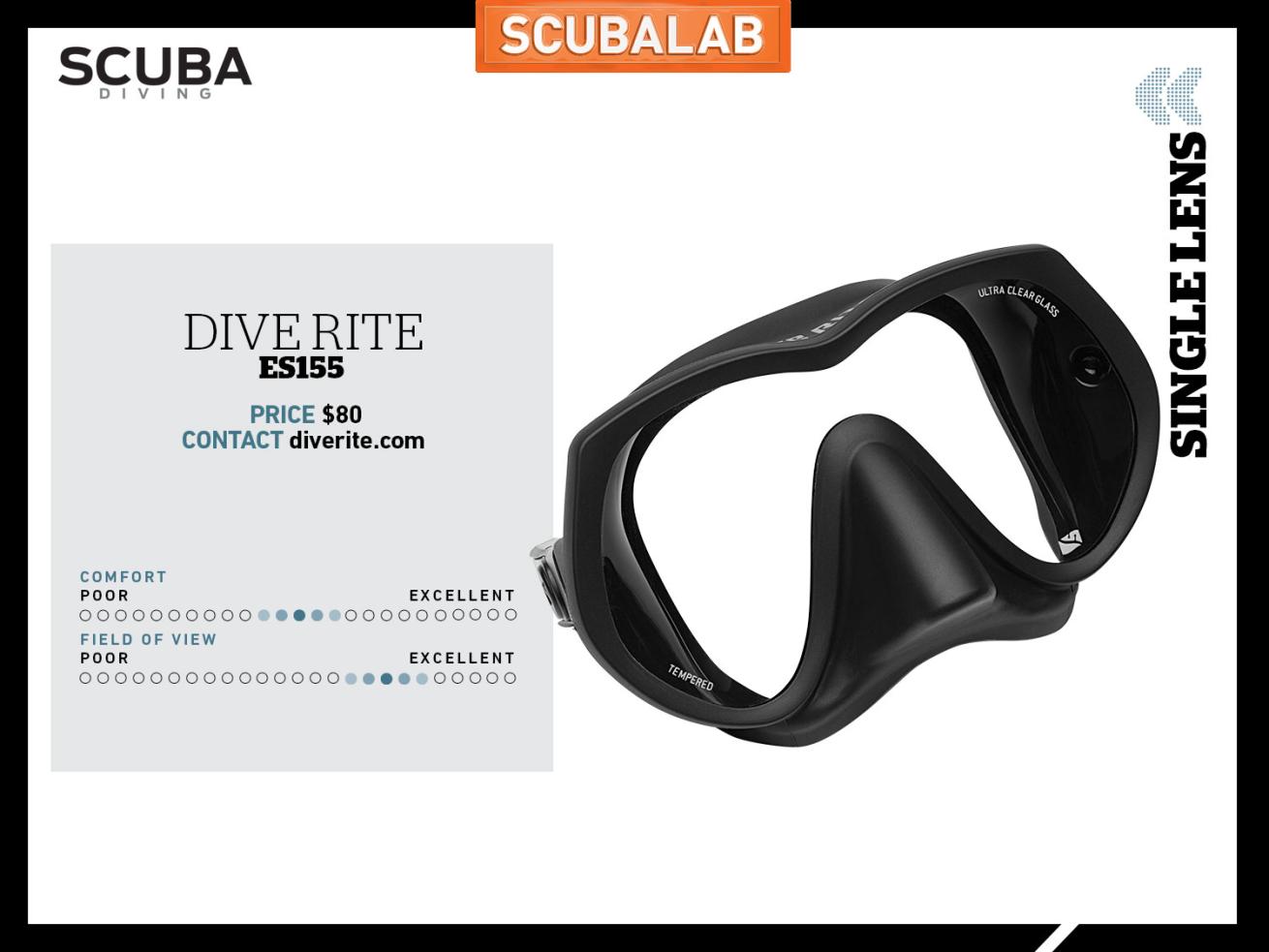
Jon WhittleDive Rite ES155
The frameless ES155 offers a wide-open view through the ultraclear glass of its lens. The skirt does a good job of sealing on a variety of face shapes, although divers with smaller faces thought the nose pocket was a bit tall and wide. The strap is comfortable and of a little heavier construction than most, with thicker sections at the adjustment tabs and at the back. We’ve seldom managed to break straps, but the beefy dimensions give us the impression the ES155 can take some rough handling. The push-button buckles attach close to the lens on soft tabs that give them enough freedom of movement for a good fit, and the overall shape of the mask allowed it to sit close to the face, making for a good view up, down and to the sides. Divers rated the ES155 very good for field of view, adjustment, dryness and ease of clearing.
Price $80 Contact diverite.com
IST Sports MP110
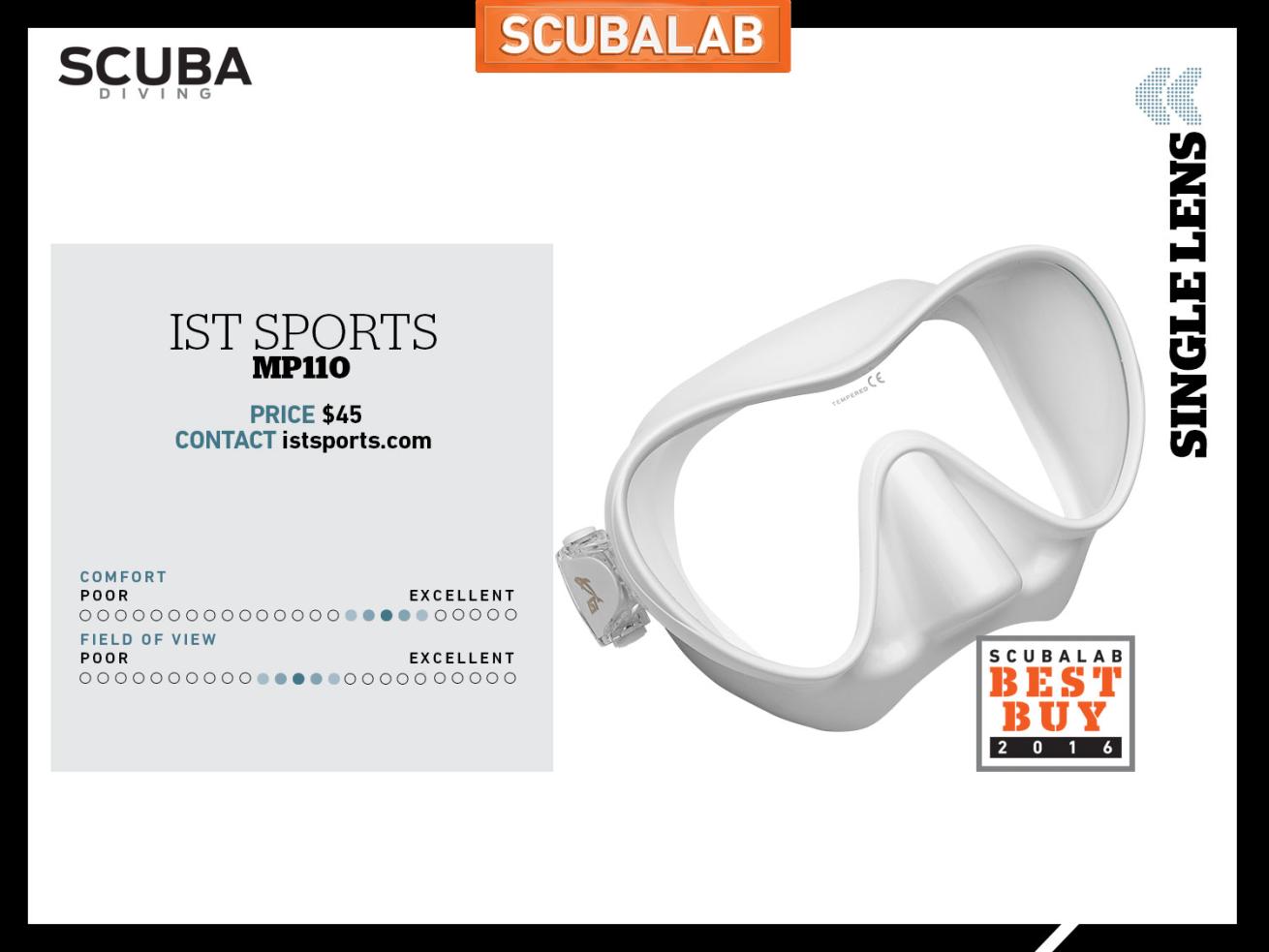
Jon WhittleIST Sports MP110
To answer the question asked most about the MP110 by test divers: Yes, it comes in colors other than all white. “Would not buy white mask,” one test diver noted. “Feel like I’m seeing way too much white,” another wrote. Point taken, but that didn’t keep the frameless MP110 from putting in a performance that had divers praising it for its comfortable fit and leak-free seal. “Totally dry in all positions,” wrote one test diver. That earned the MP110 the high score for dryness. The mask also earned very good scores for comfort, ease of clearing and adjustment. Although some divers thought the buckles were a little less intuitive than they might be (the release buttons can be mistaken for rivets), once you get it, they work without hassle, releasing easily and staying where you put them. Another plus — the MP110 was the least expensive mask in the category, earning our selection as Best Buy.
Price $45 Contact istsports.com
Poseidon Black Line Mask
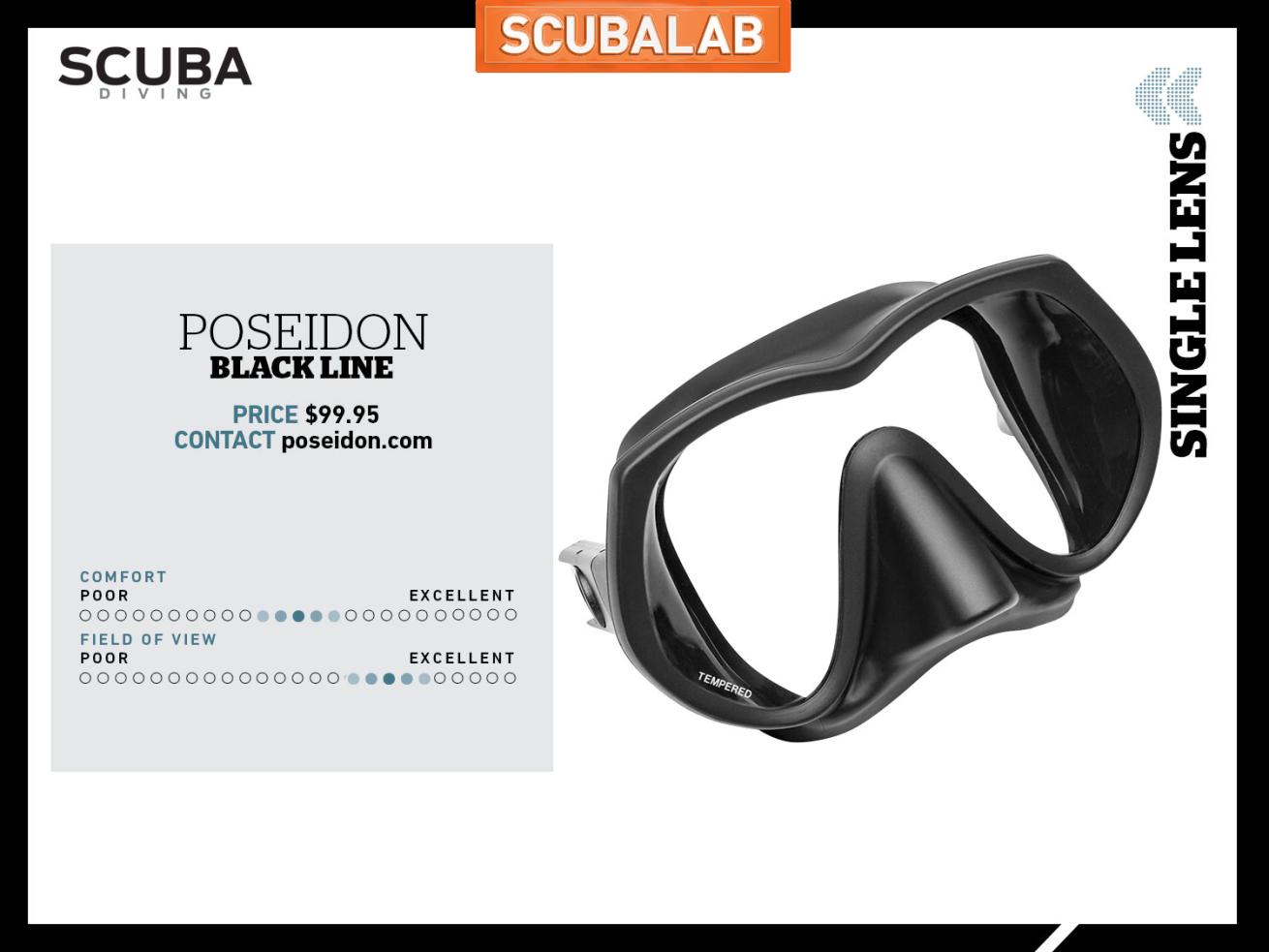
Jon WhittlePoseidon Black Line Mask
The frameless Black Line does a good job of bringing the lens in close for an uninterrupted wide-angle view. The nose pocket is roomy but soft enough to make for easy clearing. The skirt is wide and soft, with a smooth finish that sealed well and was comfortable. As with some of the other masks in this category, the lens is angled slightly downward to increase visibility in that direction. That helped the Black Line earn a very good score for field of view. The push-button buckle is straightforward, and divers rated the adjustment very good. The strap is comfortable, although it has a longer split than most; it works well with a hood, but bareheaded, the top split can ride up on the head. For a large mask, the Black Line has a minimal internal volume that made clearing easy enough, even after intentionally flooding the mask.
Price $99.95 Contact poseidon.com
Scubapro Synergy 2
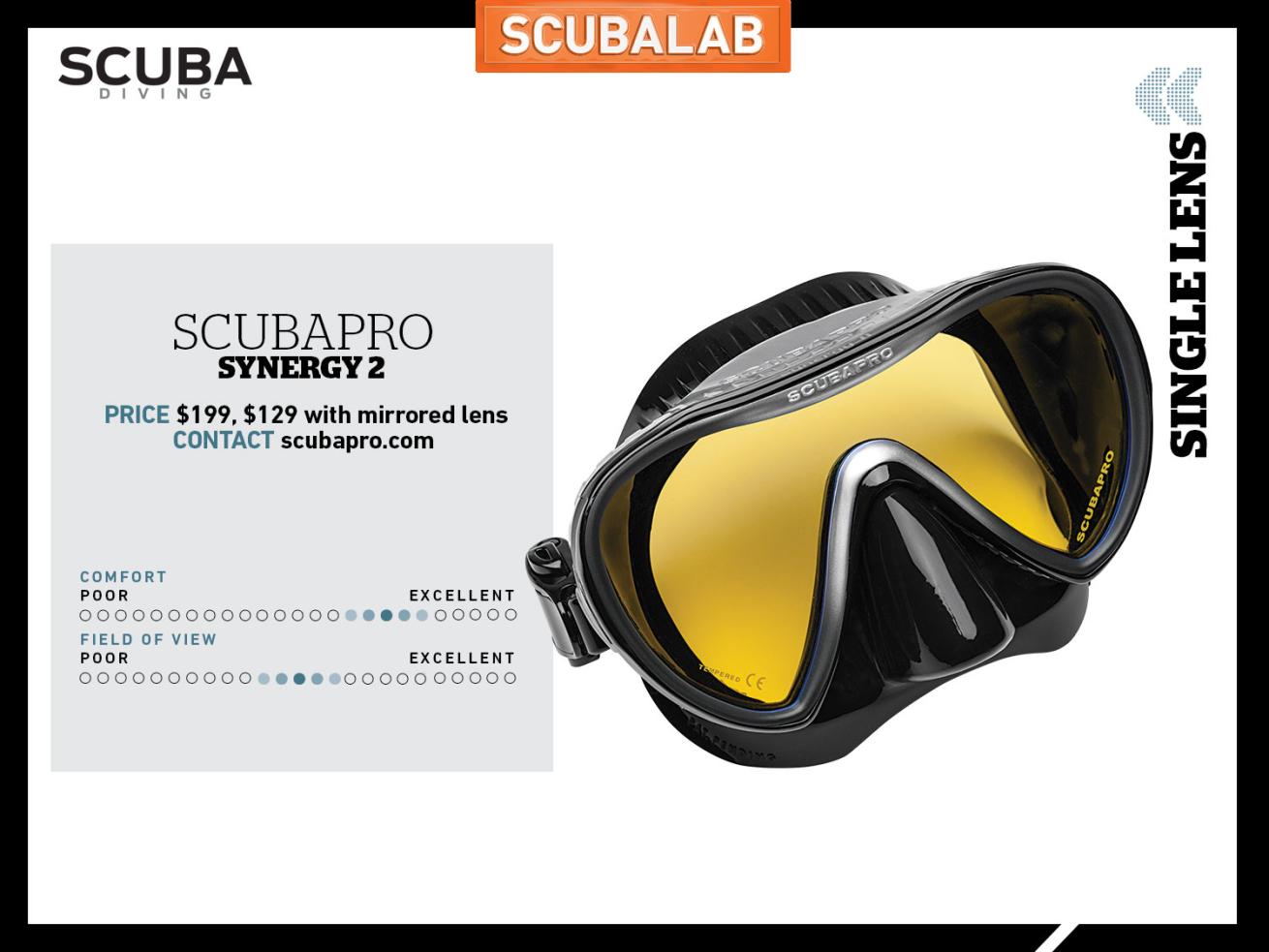
Jon WhittleScubapro Synergy 2
The skirt on the Synergy 2 is actually two skirts; there’s one thin, soft skirt, with long sealing edges, that contacts your face, and a second shorter skirt, made of stiffer silicone, that overlaps the inner skirt to provide support and form. The double-skirt design allows for a comfortable seal that doesn’t create pressure points. That helped the Synergy 2 score a very good rating for comfort and the tying top score for dryness. Divers also praised the strap system and buckles, which pivot on flexible tabs on the skirt. The Synergy 2 took the top score for ease of clearing — no surprise, given that it was more compact than most of the single-lens masks we tested. We tried the Synergy 2 with a mirrored lens, with an amber hue that increased contrast on a cloudy day, but it's also available with a clear lens. Despite its compact size, the Synergy 2 offered a good field of view but fit best on divers with medium to smaller faces.
Price $119; $129 with mirrored lens Contact scubapro.com
Tusa M1001 Freedom HD
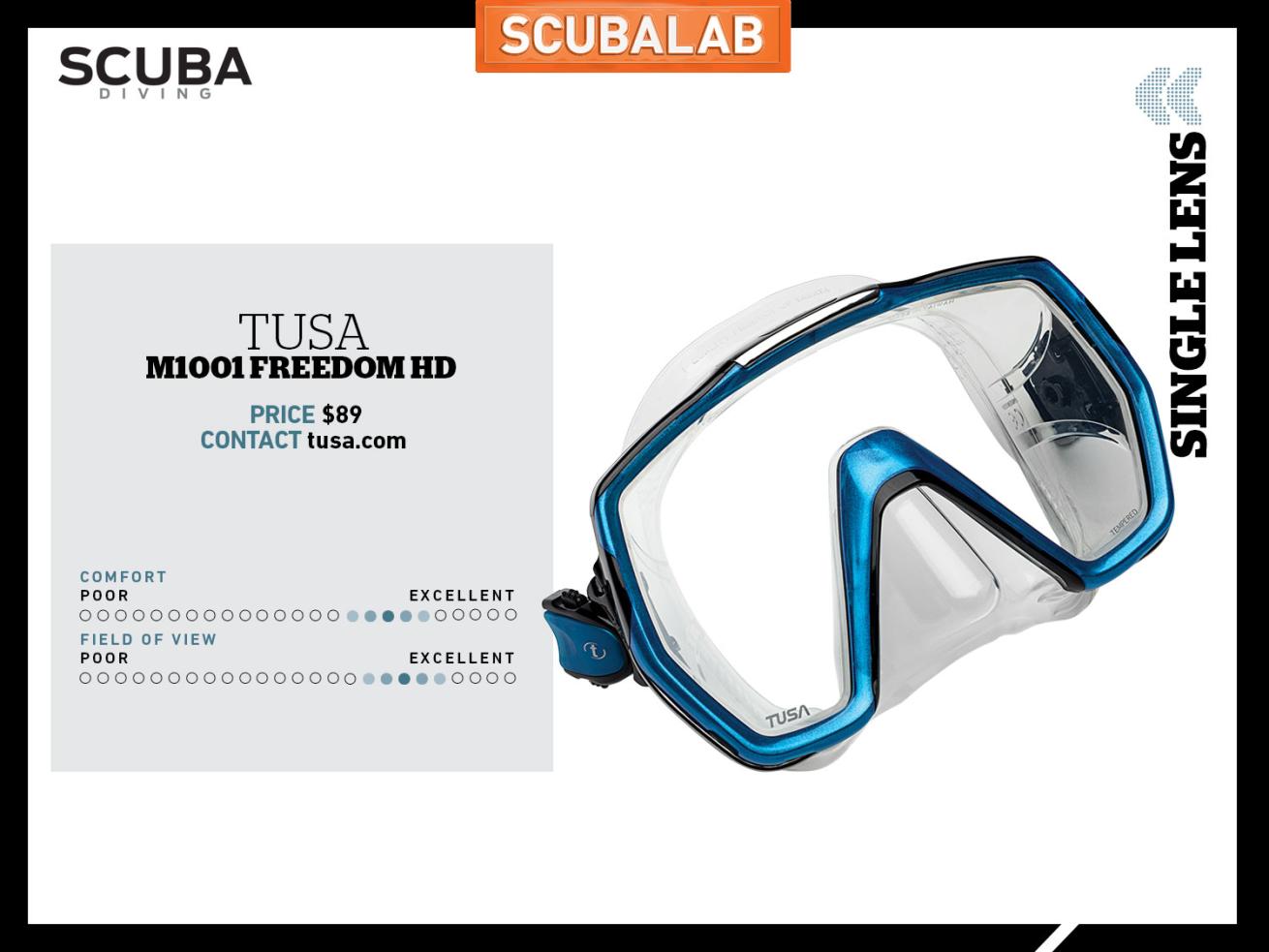
Jon WhittleTusa M1001 Freedom HD
The huge lens of the Freedom HD — 6 inches across and more than 3 inches top to bottom — provides a jumbo view. “I can’t even see the top of the mask,” one test diver noted. That earned it top score for field of view in the test, but the more impressive part of the mask’s performance is that despite its size it was still easy to clear, and it fit comfortably on a variety of face shapes. It also displayed a nice attention to detail in design and execution. The stainless frame clips at top and sides give it a finished look, and the buckles and strap are well thought out. The buckles are hinged to swivel 180 degrees on the frame, and they also rotate up and down, clicking into five detent positions for precise micro-adjustment to keep the strap comfortably placed. “Really nicely designed and made,” was how one test diver described it.
Price $89 Contact tusa.com
XS Scuba Crew
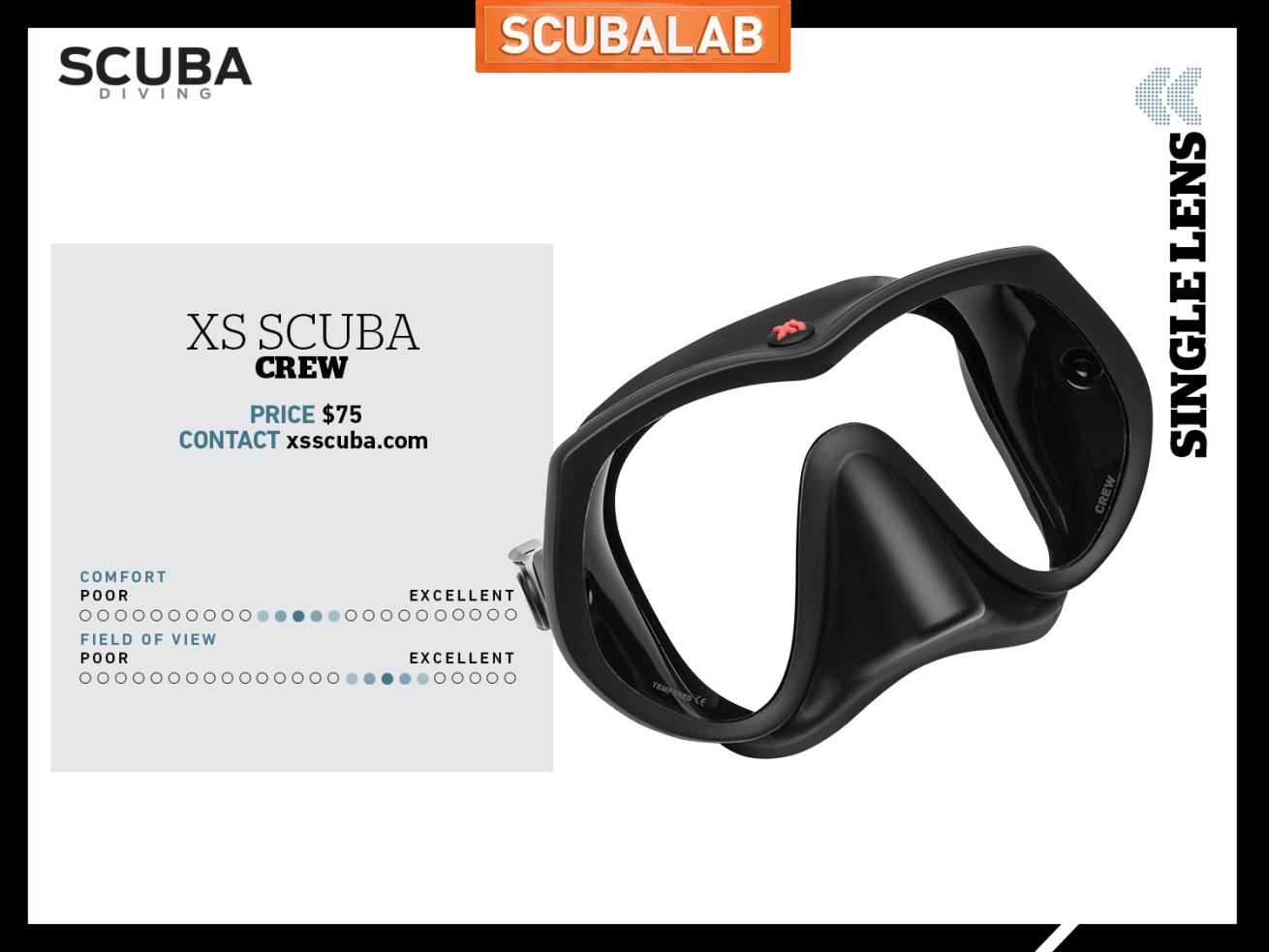
Jon WhittleXS Scuba Crew
The Crew shares a frameless design similar to several masks in this category, with a comparably wide field of view and a small internal volume for a mask its size. The push-button buckles work well; they aren’t 3-D, but they’re attached to silicone tabs that allow a fair amount of movement for proper placement. The adjustment notches on the strap are spaced a little closer than most of the other masks, which allows for a more precise adjustment. The slight downward angle of the lens helps increase the field of view in that direction. The mask fit a variety of face sizes, although some divers reported the nose pocket was a bit oversize, making it tough to pinch the nose. The smooth skirt did a good job, earning the Crew a very good score for comfort and dryness. It also was rated very good for adjustment and field of view.
Price $75 Contact xsscuba.com
Hollis M3
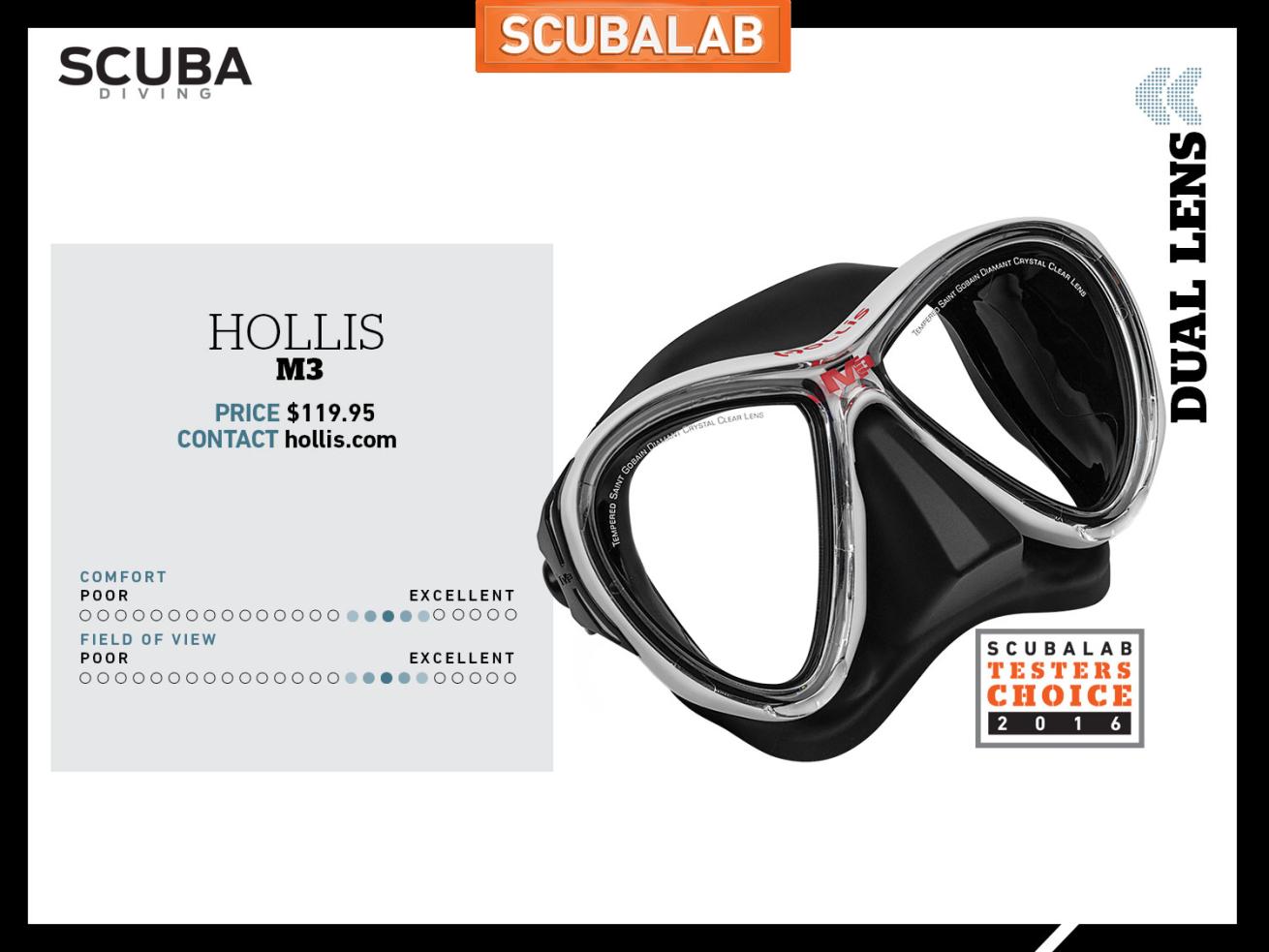
Jon WhittleHollis M3
The M3 shares with many of the masks here a design with a wide field of view and low volume. But what impressed test divers was the comfort and dryness of the M3, which won top scores in both categories. The skirt is a conventional design, but the finely tapered edges and ribbed stiffeners along the sides make for a very soft, supple fit. The buckles attach to the frame and swivel up and down and side to side for just-right strap positioning, and the strap stays comfortably in place. The lenses are of a low-iron-content glass for greater light transmission. The nose pocket has a boxy shape that felt odd to some divers but was large enough to avoid chaffing and supple enough for easy use. “Great all-around mask; excellent field of view," one test diver summed it up. The M3 is our Testers Choice in this category.
Price $119.95 Contact hollis.com
Body Glove Fusion
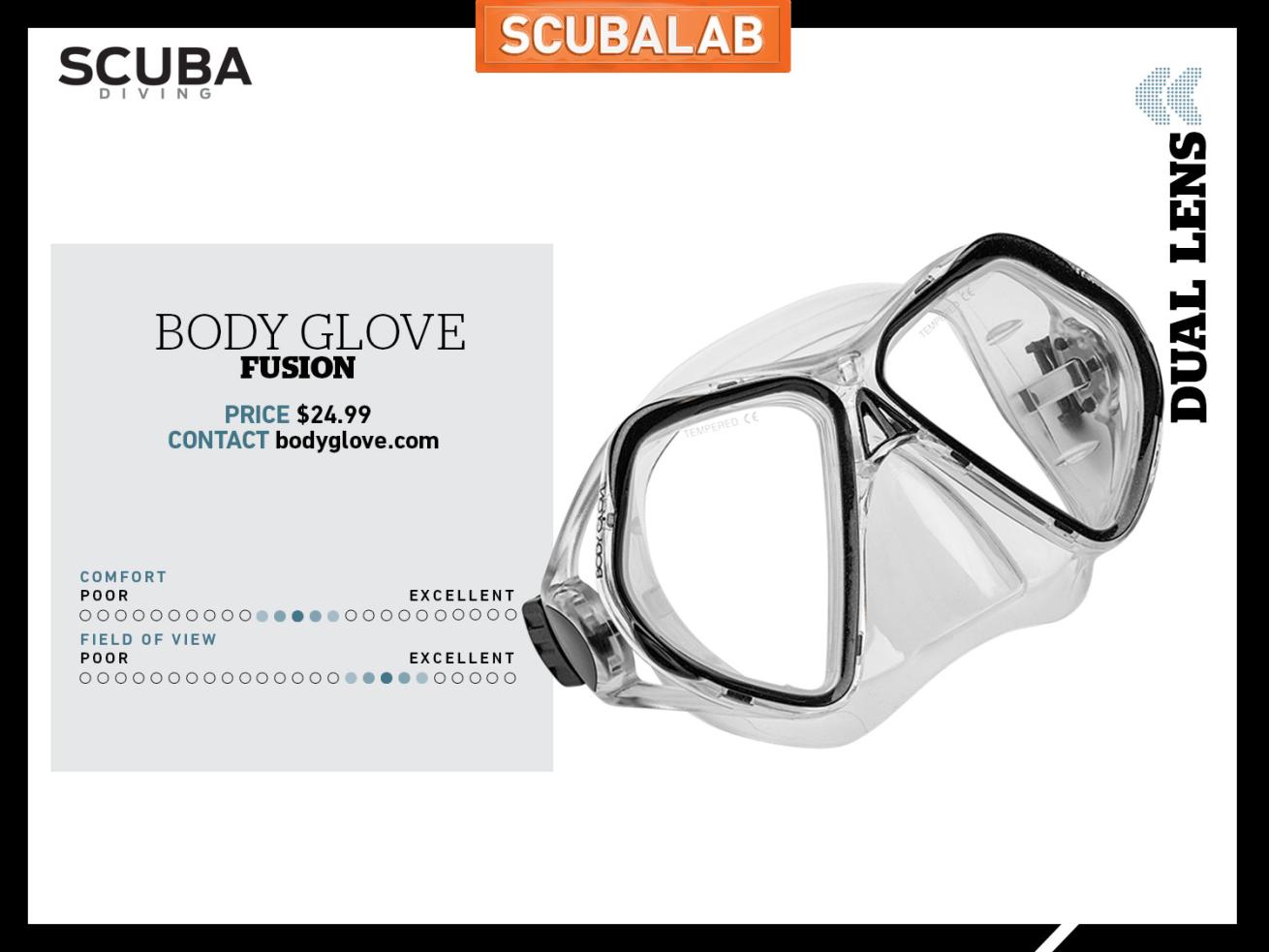
Jon WhittleBody Glove Fusion
The Fusion tied the top score in its category for field of view, thanks to the broad, deep inverted-teardrop shape of the lenses. The strap buckles are supported on rigid arms that extend out from the sides of the frame; they are easy to adjust and stay in place well, earning a rating of very good from divers. The buckles also swivel up and down, but unlike the other masks here, they don’t swivel side to side. That, plus the slightly thicker, stiffer silicone skirt on the Fusion, caused fit and sealing issues for some divers. The nose pocket is on the wide side, which keeps it from rubbing on those with more generously sized sniffers, but the thicker silicone makes it a little tough for some divers to pinch their noses. Overall the Fusion performed well considering its price is about one-third of the average in its category.
Price $24.99 Contact bodyglove.com
Cressi Air
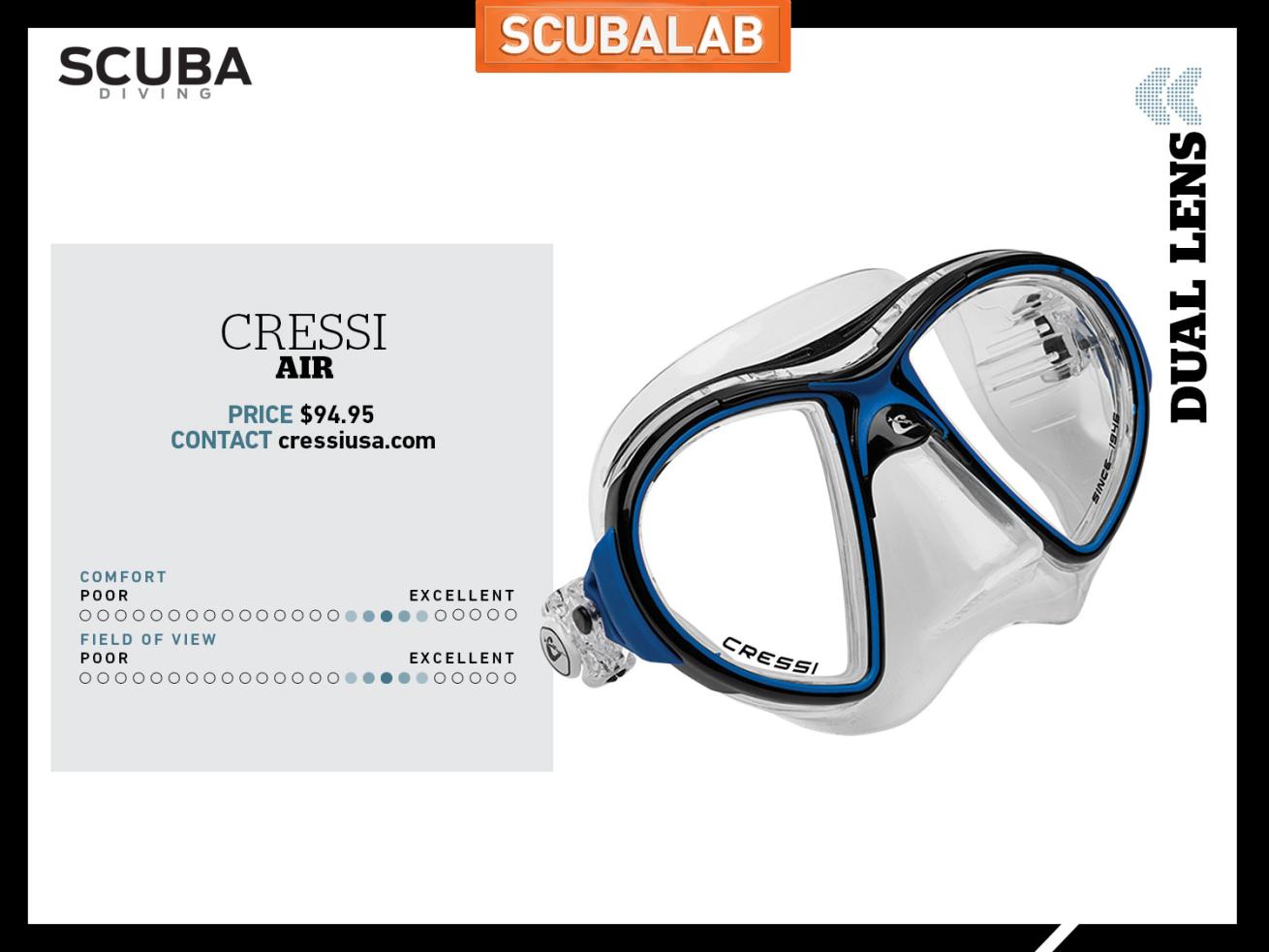
Jon WhittleCressi Air
With its face-hugging design, the Air tied high scores in its category for low volume and wide field of view. It also racked up above-average scores for comfort and dryness because of its skirt design, which was unique among the masks in our test. The skirt has small creases, accordion-like, where it attaches to the frame. That allows the skirt to move a bit for a precise fit. The skirt also has small ribs and slightly thicker layers where more support is needed, helping to keep it in smooth contact with the skin. The result is a second-skin fit that is comfortable and effective at sealing. Also boost- ing comfort are the soft, flexible tabs on the frame that are used to attach the swiveling buckles. Impressively comfortable and dry, the Cressi Air was one of the top scorers in our test.
Price $94.95 Contact cressiusa.com
&nsbp;
Mares Viper
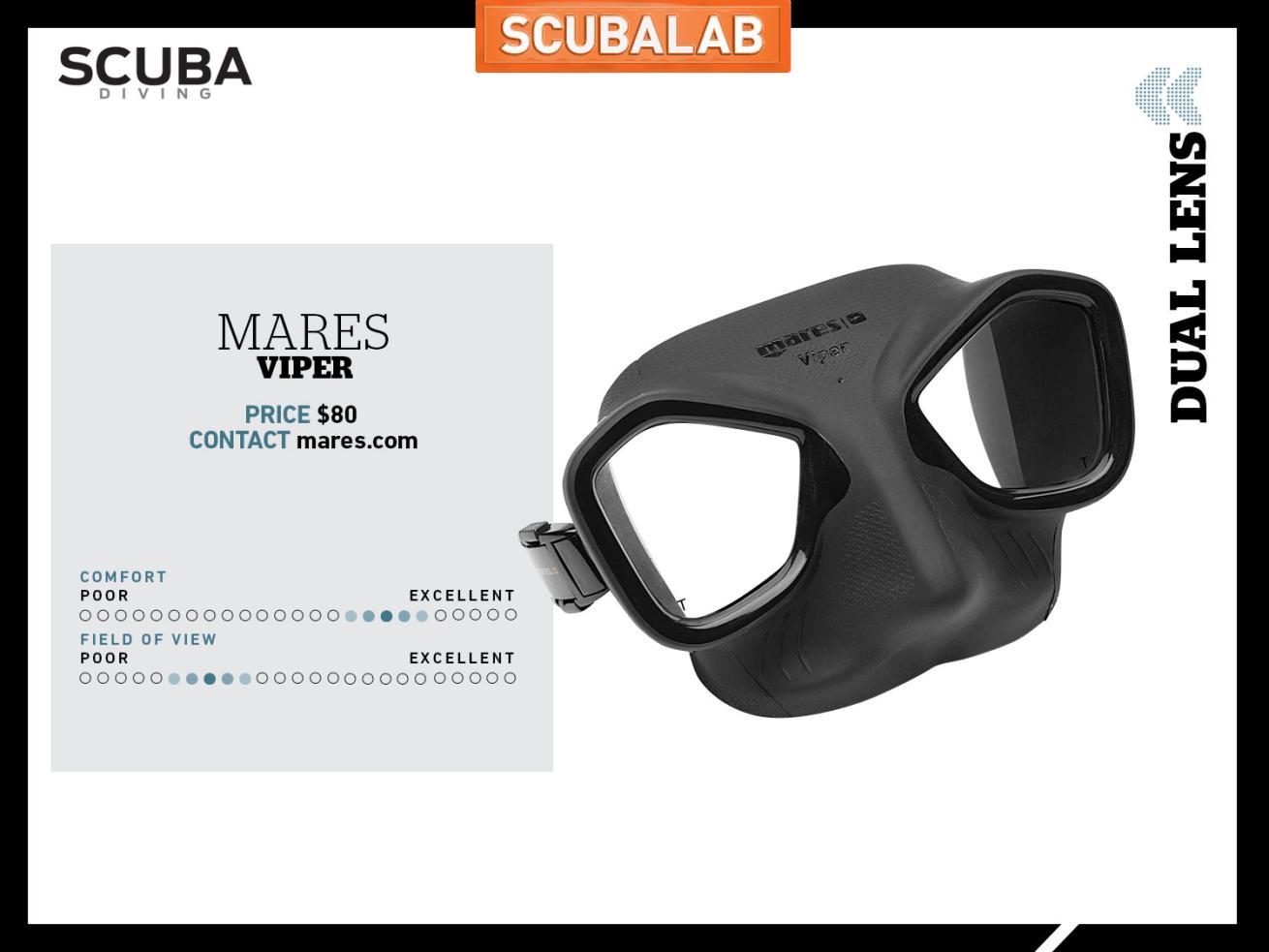
Jon WhittleMares Viper
Clearly displaying its freediver heritage, the Viper takes low volume to the extreme with a tiny, stripped-down design that gives it a superhero (or supervillain?) look. No surprise it earned one of the top scores for ease of clearing and equalizing. Not so expected was the performance of the skirt, which unlike the other masks here, has a single edge, with a rounded taper and smooth section where it contacts the skin (the rest of the skirt has a matte finish). That single skirt was surprisingly effective at sealing, and test divers rated the Viper very good for dryness and comfort. Divers were split on the aesthetics of the Viper and on its field of view, which some divers found limited. But the Viper’s comfort and clever design, with the frame molded right into the skirt, makes us think scuba masks could learn a thing or two from freediving masks.
Price $80 Contact mares.com
OMS Two-Window Frameless
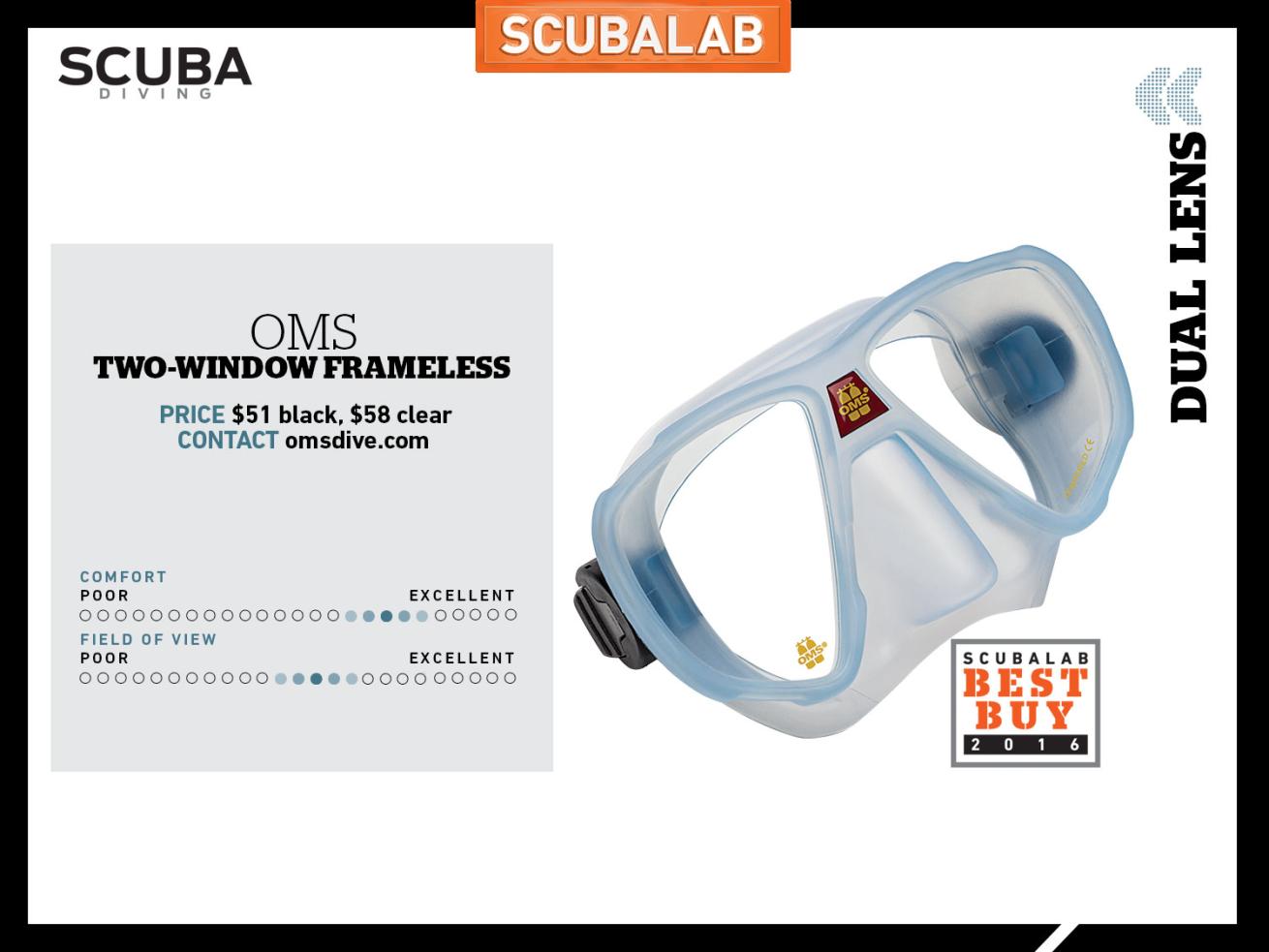
Jon WhittleOMS Two-Window Frameless
The frameless design allows a close-up fit without a frame to rub or press on the forehead — a key reason divers rated this mask very good for comfort. Another was the nose pocket, which has a size, shape and suppleness that seemed to satisfy all; divers described it as “butter soft” and “perfect.” The wide, soft skirt helped earn a tying high score for dryness. The buckles are nothing fancy, but they do the job without fuss, earning the top score for ease of adjustment. Tabs on the strap are easy to grasp, the strap keepers stay in place and the buckle releases are easy to use. Also, the pins that attach the buckle to the skirt and the strap are stainless rather than plastic, a nice touch. For its impressive performance at a price well below the average here, the Two-Window Frameless is our Best Buy in this category.
Price $51 black, $58 clear Contact omsdive.com
Seac L70
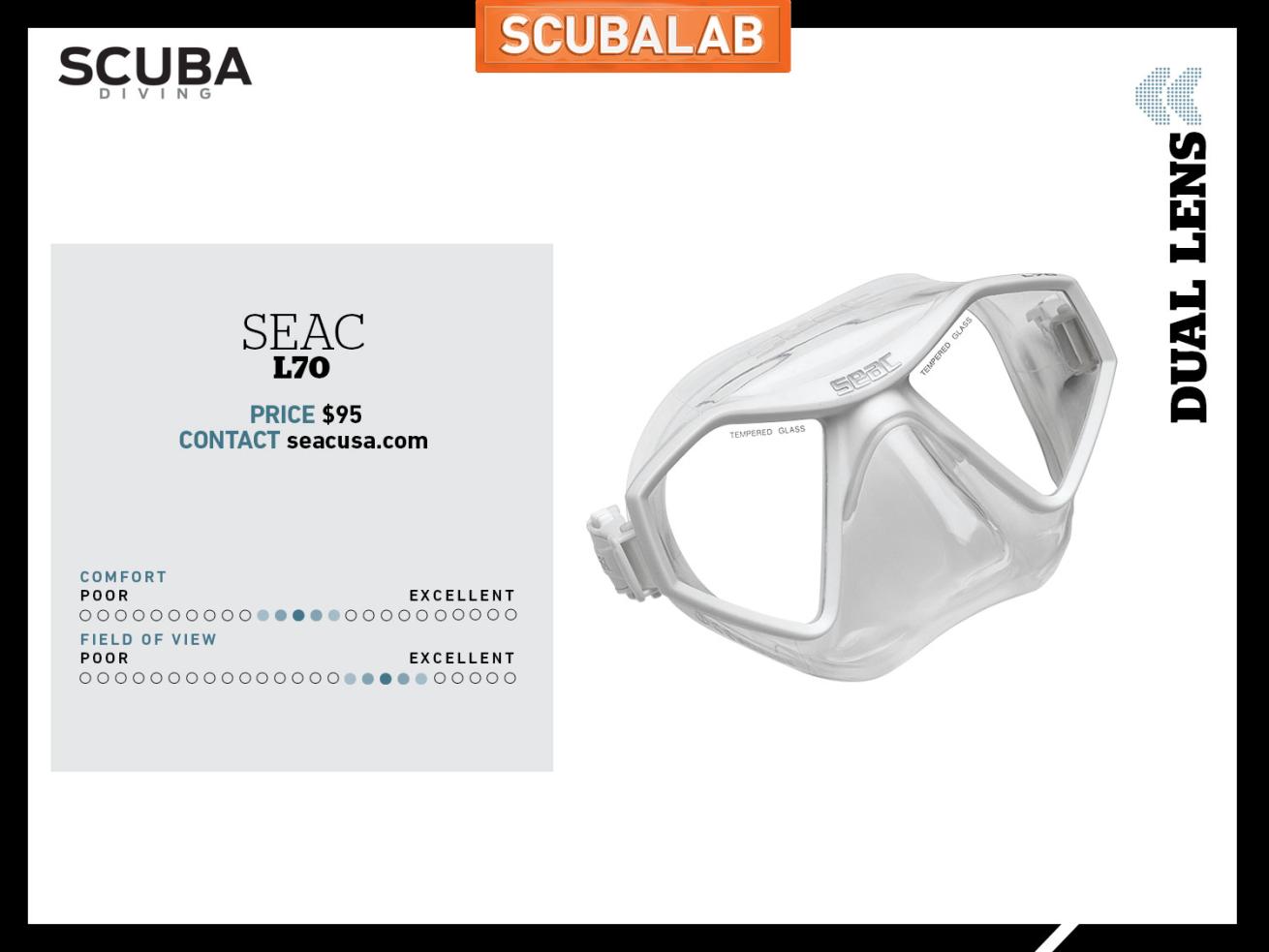
Jon WhittleSeac L70
With its semi-frameless design, ultralow volume and minimalist proportions, the L70 has the look of a freediving mask. The model we tried, with its white frame and clear skirt, had us reaching up to make sure we had a mask on before entering the water. The small volume and close-to-the-eyes design earned the L70 very good ratings for field of view and for ease of clearing and equalizing. Despite its size, the L70 has a generously sized nose pocket, and the mask fit a variety of face sizes. Some divers noted the close-fitting design perceptibly reduced drag, and liked the almost painted- on feel of the mask. Others divers found the L70 a little too little, with the 3-D buckles feeling a bit insubstantial and the mask so close fitting that their eyes seemed too near the lenses. But for divers who want a mask with a wide field of view and ultralow volume, the L70 fits the bill.
Price $95 Contact seacusa.com
Sherwood Scuba Vida
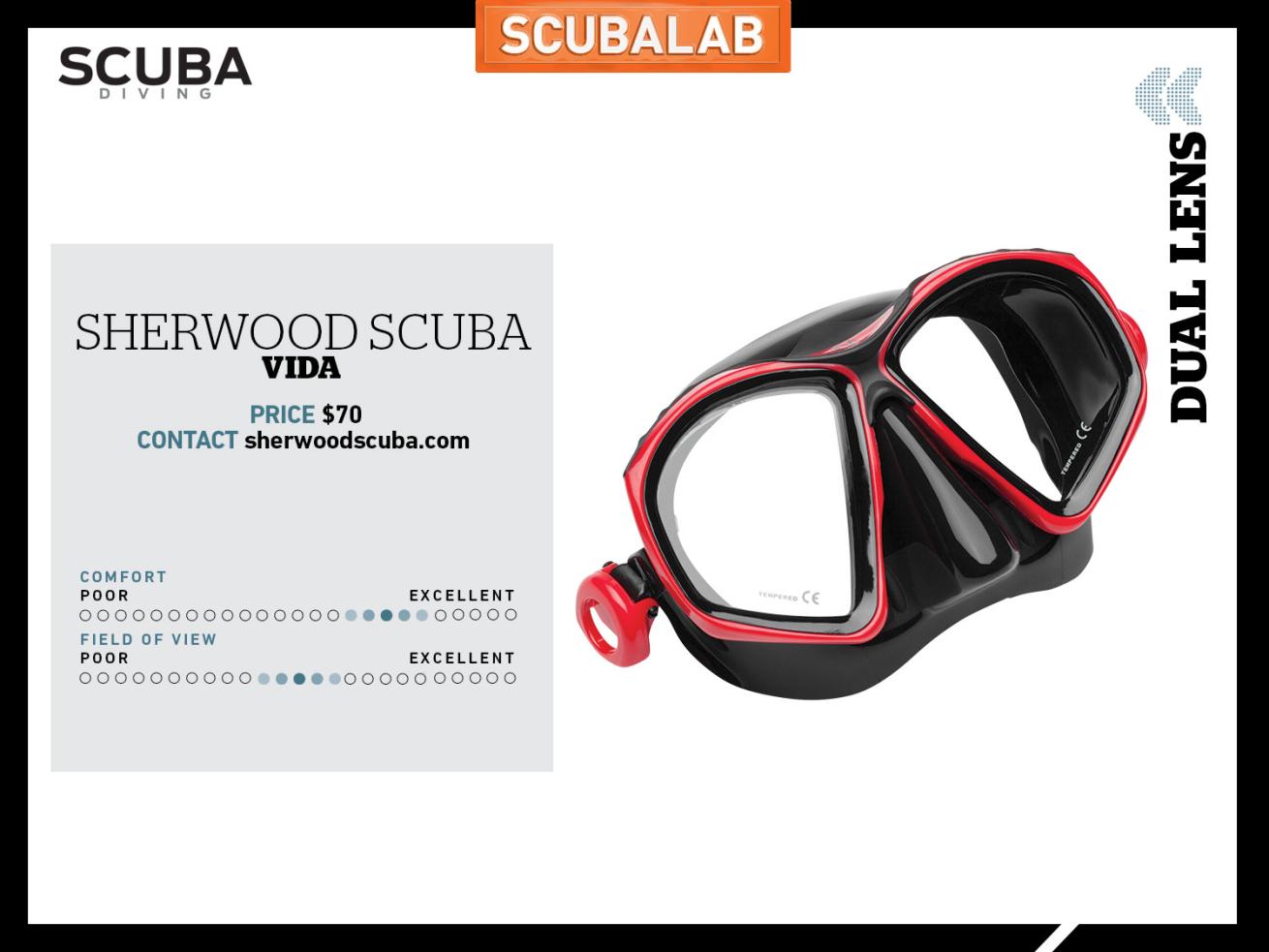
Jon WhittleSherwood Scuba Vida
The Vida’s design displays a lot of attention to detail; one example is the nose pocket, which has small textured patches on each side to aid grip while the frame on both sides of the nose pocket is narrowed just slightly to give your fingers a little extra room when pinching your nose. The arrangement is effective enough that most divers commented on it. Another feature is the co-molded frame, which bonds different colors and textures of material and has tapered, rear-facing tabs at the top that prevent the mask from being overtightened or riding uncomfortably on the forehead. Some divers thought the Vida’s strap was a bit narrow for comfort. But the quick-release 3-D buckles, which attach to silicone tabs on the skirt, helped the Vida earn a very good score for comfort. It was also rated very good for adjustment, dryness and ease of clearing.
Price $70 Contact sherwoodscuba.com
Tilos Senza
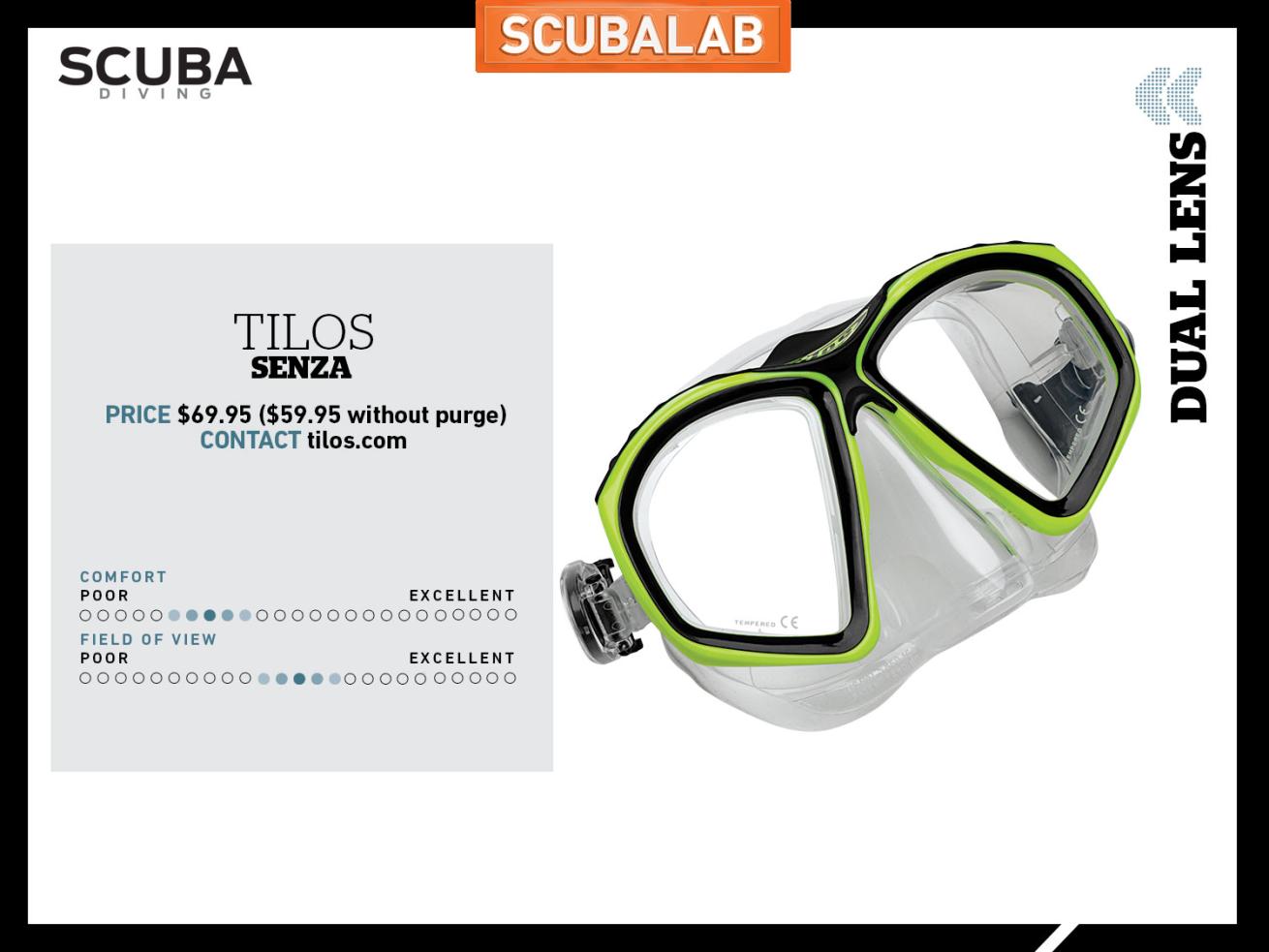
Jon WhittleTilos Senza
The Senza was the only mask we tested with a purge valve in its category (it's also available without the purge). Otherwise, it shares several design features with the Sherwood Vida, including an overmolded frame with feathered top tabs to prevent overtightening the mask. It also has a nose pocket with side grips and indents in the frame. But on the Senza, the purge valve, located at the bottom of the nose pocket, made it tough for some divers to pinch their nose. The purge valve has a hard-plastic button on its top edge, and sat uncomfortably close to the nose for some divers. Those who didn’t have that problem reported that the purge did a good job of removing stray water without any conscious effort, earning a score of very good for dryness. The strap and quick-release 3-D buckles were fuss-free and got a very good score from divers.
Price $69.95 ($59.95 without purge) Contact tilos.com
Buying a dive mask is one of the best gear investments to make for any level of diver, so it's important to know how to find one that fits your face and style of diving. Here, we test the best masks on sale and show you how to find the perfect one.
HOW WE TEST DIVE MASKS
Dive Mask Test Protocol:
To evaluate the in-water performance of each dive mask, a team of ScubaLab test divers dived with them at Alexander Springs in central Florida. Using underwater slates and waterproof test sheets, divers scored each scuba mask in five performance categories. Our team of divers also recorded comments about their experience with each mask and ranked in order their top three favorites in each of two mask categories — dual-lens and single- lens models.
Ergo Test Categories:
- Ease and security of adjustments, including buckles, swivels and quick releases
- Comfort of the strap, skirt, frame, nose pocket and all contact points
- Dryness overall, and effectiveness of seals and purge valves
- Field of view, both vertical and horizontal
- Mask volume and ease of clearing and equalizing
Because of the importance of proper fit, individual test divers did not proceed with in-water testing if a mask failed to fit him or her properly.
HOW WE SCORE MASKS
Shown on the graph accompanying each mask are that mask's scores for comfort (including the strap, skirt, frame and contact points) and field of view (both horizontal and vertical, as perceived by the diver). The scoring is as follows: 5 = excellent; 4 = very good; 3 = good; 2 = fair; 1 = poor. Test divers also selected their top three favorite masks in each of the two test categories — dual lens and single lens.
MULTI-LENS VS. SINGLE LENS
The choice between mask types is partly a matter of personal preference and partly a function of special requirements a diver might have. Multi-lens masks, especially dual-lens models, generally have a smaller internal volume than single-lens models because their smaller size can allow them to be shaped closer to the diver’s face. A smaller volume is beneficial because it makes a mask easier to clear and equalize. They also can be equipped with corrective lenses, which many manufacturers offer for their most popular masks. Single-lens masks offer the widest uninterrupted field of view because they don’t have the obstruction of the nose bridge needed on a dual- or multi-lens mask. Single-lens masks can’t be fitted with corrective lenses and generally have somewhat larger volume, although many newer designs have significantly reduced volumes.
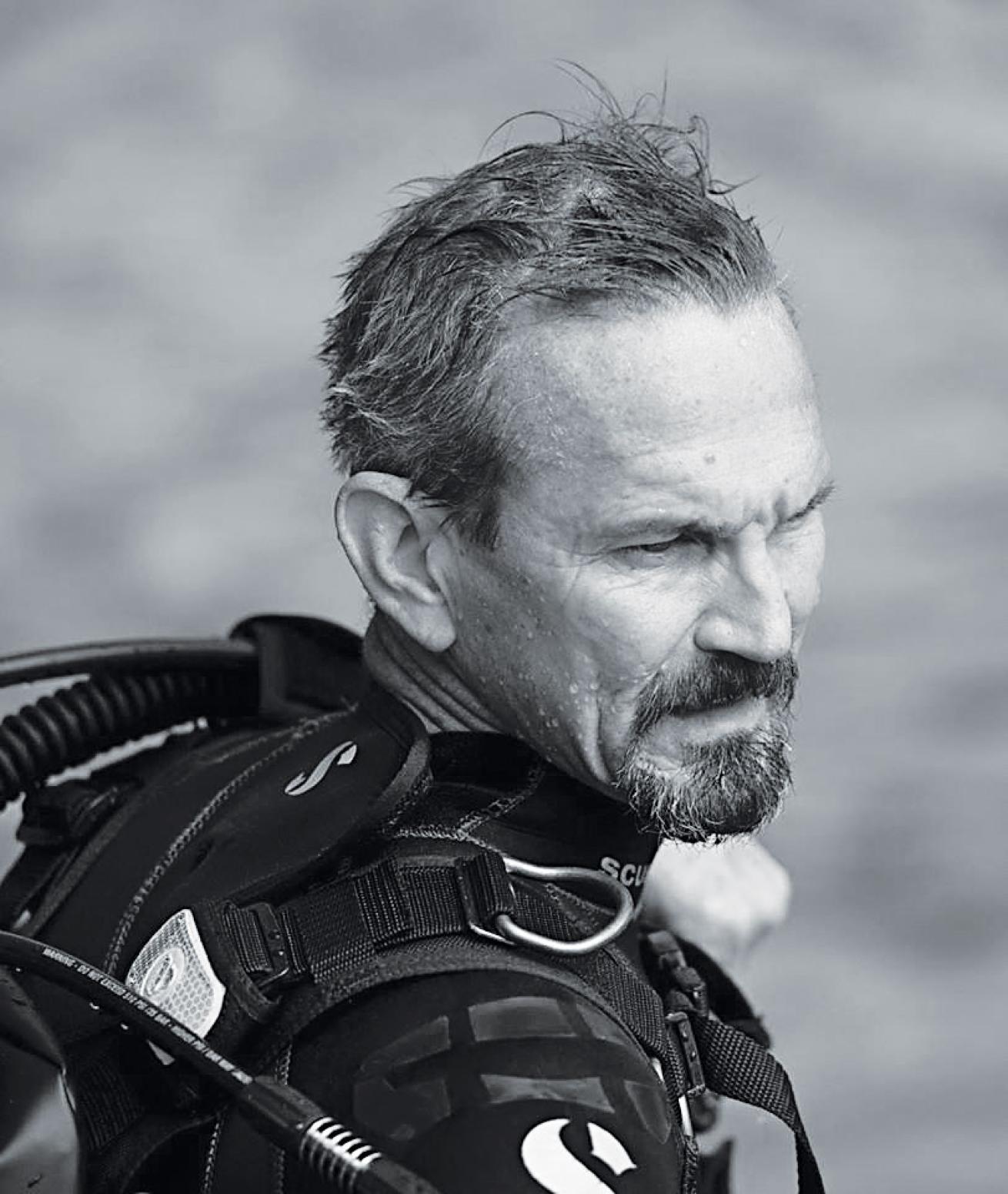
Staff PhotographerScubaLab Director, Roger Roy
Q: What factors did test divers find most important?
A: Test divers’ favorite masks took top scores for comfort, with supple skirts, soft nose pockets and no hard parts contacting the face. That's no surprise because an uncomfortable mask can quickly take the fun out of any dive.
Q: What are the pros and cons of frameless masks?
A: Molding the skirt directly to the lens gives the frameless mask a lower profile and eliminates any visual obstruction the frame might cause. Because the frameless masks' lenses aren’t removable, they can’t be fitted with corrective lenses or replaced. — Roger Roy, ScubaLab Director
SEE MORE SCUBA GEAR REVIEWS
Ever wondered why you came up with blood in your dive mask? The Diving Doctor explains what may be causing those nosebleeds.



